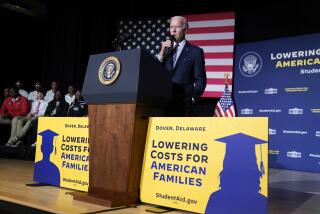Fed Eases Its Rules to Spur Farm Loans
- Share via
WASHINGTON — The Federal Reserve Board on Friday relaxed its lending rules to rural banks, a step that could cut loan rates to farmers by up to two percentage points and enable more of them to qualify for federally guaranteed loans in time for spring planting.
“This is a welcome step,” said Weldon Barton, executive director of the Independent Bankers Assn. of America, which represents most of the nation’s rural banks. “It can assist in many cases.”
Sheldon Golub, a spokesman for the American Bankers Assn., added: “The Fed’s action is certainly going to be helpful for both the farmer and the banker. It is going to provide additional incentive for bankers” to participate in a federal loan-guarantee program designed to help relieve the worst farm crisis since the Great Depression.
The spokesmen for the two bank groups said it is impossible to estimate how many additional farmers will receive loans as a result of the Fed action. But Barton said it will probably be fewer than the 35,000 that he estimated would have been helped by an emergency debt-relief bill vetoed by President Reagan on Wednesday.
Reagan said in his veto message that the bill was too expensive and that the Administration’s existing debt-assistance program was adequate.
So far, rural banks, many of them in desperate financial circumstances themselves, have used only $25 million of the existing $650-million loan-guarantee program. They have protested federal regulations governing the program that, they say, require them to charge unprofitably low interest rates and fail to provide sufficient federal compensation for defaulted loans.
The Fed’s action involves its “seasonal credit program,” under which banks that experience seasonal swings in deposits and loan demands may borrow directly from the central bank when they are strapped for funds. The central bank lends the money at a substantially lower interest rate--now 8.5%--than is available on the open market.
The Fed limits the amount of money that banks may borrow this way. In Friday’s action, it eased borrowing requirements for small- and medium-sized agricultural banks, thus making significantly greater amounts of low-cost money available to them.
The farm banks in turn will be able to reduce the interest rates that they charge on their loans to farmers. This is crucial because the banks, to qualify for federal loan guarantees, are required to reduce interest rates enough to demonstrate that borrowing farmers could break even on their bills. With many banks unwilling to dig into their reserves to reduce interest rates on their own, tens of thousands of desperate farmers have been unable to obtain loans.
Bank spokesman Barton estimated that the Fed action will enable banks to lower interest rates by one or two percentage points, enough in many cases to “get a farmer to cash-flow”--that is, to demonstrate that he could break even for purposes of qualifying his loan for a federal guarantee against default.
“I emphasize this will very much depend on the specific circumstances of banks and borrowers,” Barton said.
Existing Fed rules limit the amount of money that banks may borrow from the central bank at lower interest rates. In order to borrow from the Fed to finance its loans, a farm bank’s own contribution to the loans that it makes must equal 4% of the first $100 million of its deposits and 7% of the second $100 million.
Those percentages were changed on Friday to 2% and 6%. For deposits above $200 million, the requirement remains at 10%.
In addition, the Fed said it will operate through September a more simplified borrowing program, allowing very small agricultural banks with less than $200 million in deposits to finance nearly half their loan growth with borrowings from the central bank.
About 600 banks participated in the Fed’s program last year, and the amount borrowed at any given time ranged from $100 million to $300 million.
Fed officials had no estimate of how many additional banks might be encouraged to participate this year under the liberalized rules. About 4,146 of the more than 14,000 U.S. commercial banks are classified as agricultural banks.
More to Read
Inside the business of entertainment
The Wide Shot brings you news, analysis and insights on everything from streaming wars to production — and what it all means for the future.
You may occasionally receive promotional content from the Los Angeles Times.










